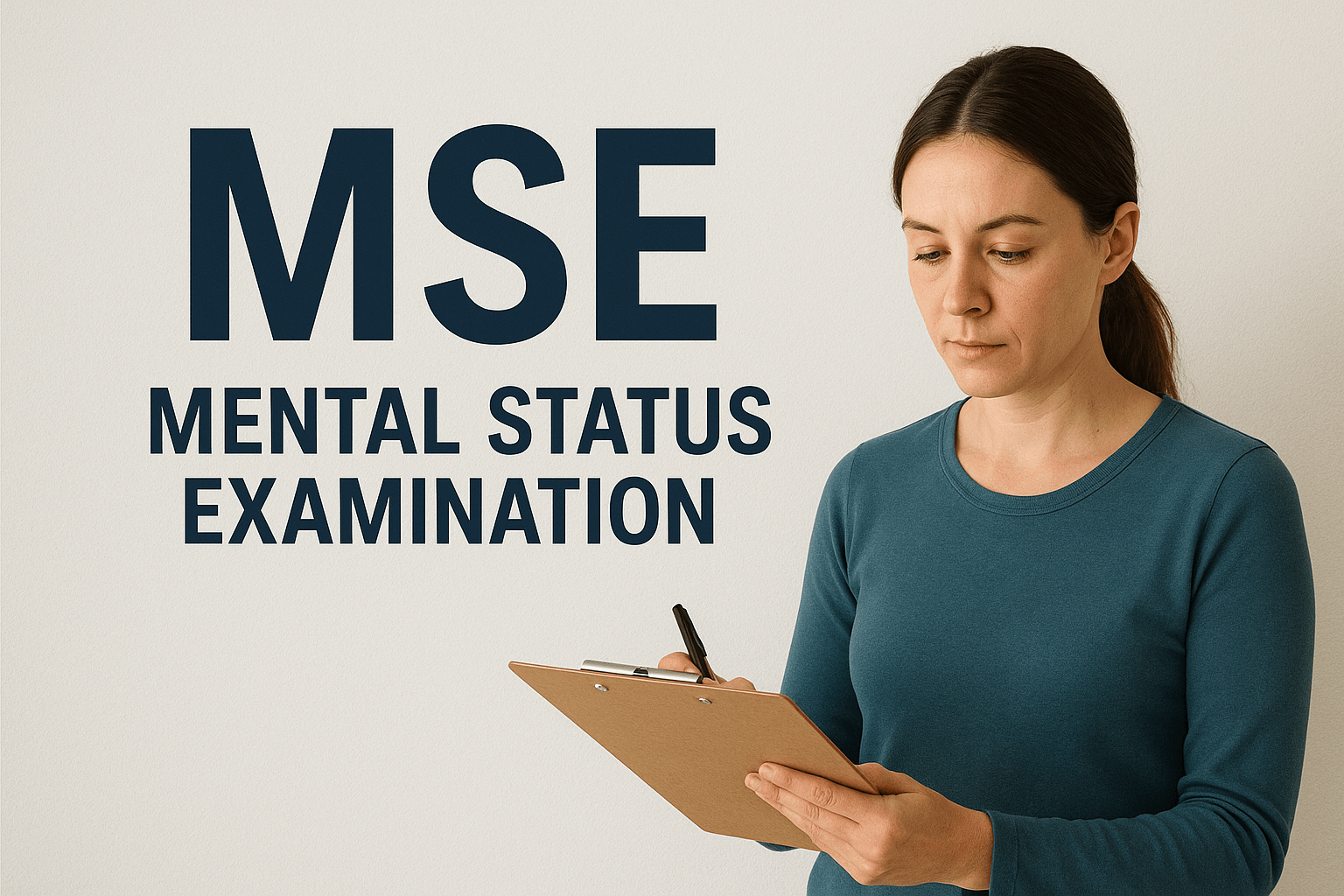
What is Mental Status Examination
The mental status examination is a methodical evaluation of the patient’s cognitive and behavioral abilities. The patient’s appearance and overall behavior are described, along with their level of consciousness and attentiveness, motor and speech activity, mood and affect, thought and perception, attitude and insight, the examiner’s reaction, and, lastly, higher cognitive abilities. The most clinically relevant cognitive processes are those related to alertness, language, memory, constructional ability, and abstract reasoning.
Techniques Used in Mental Status Examination
Mental status testing often intimidates patients and demands significant cooperation. Therefore, the examiner performs it best at the end of the evaluation, when the patient feels more relaxed and rapport has been established. In many ways, the mental status examination is harder to systematize. It does not lend itself as easily to a structured approach as other parts of the patient examination.
However, the patients’ mental state affects the sensitivity and accuracy of the entire medical history. For this reason, the doctor wishes they could conduct a mental status examination before the rest of the medical history so that the evaluation can serve as a standard by which to gauge the accuracy of the remaining information.
A successful clinician adopts a style that conducts much of the mental status examination through comparatively unstructured observations during the standard physical and history. The clinician gathers valuable information about the patient’s appearance, behavior, alertness, speech, activity, affect, and attitude from the way the patient describes the history of their current illness.
A primary technique in mental status testing is to add structure to observations. This process transforms subtle impressions into clinically useful descriptions of behavior. A formal assessment of specific cognitive abilities should take place near the end of the visit. It becomes necessary when there is evidence of significant psychiatric illness, abnormal thinking or behavior, neurological abnormalities, or difficulties in daily social or professional functioning. So, the clinician encourages cooperation by carefully introducing the patient to the examination and briefly explaining its purpose.
Components of MSE
Parts of the mental status examination are as follows:
Appearance and general behavior
The examiner gets a general idea of the patient from these factors. Relevant observations include the patient’s posture, eye contact, attire, grooming, and physical appearance. Behavior observation makes it easy to understand some specific syndromes, such as unilateral spatial neglect and the frontal lobe syndrome’s disinhibited behavior.
Speech and motor activity
The examiner gathers helpful information by listening to the patient’s unstructured speech as they respond to open-ended questions. The examiner can identify articulation or output issues, such as the hypophonia of Parkinson’s disease, the halting speech of a patient struggling to find words, or the rapid and strained speech of an excited or amphetamine-intoxicated patient. It’s also important to record general motor activity, including any tics or odd behaviors. For instance, Akathisia, or motor restlessness, may indicate an extrapyramidal syndrome caused by phenothiazine use. In contrast, slowness and loss of spontaneous movement may signal subcortical dementia or depression.
Affect and mood
Mood describes the patient’s longer-term emotional composition, whereas affect describes the patient’s immediate emotional expression. Patients exhibit a spectrum of affect that can be characterized as flat, labile, restricted, or broad. Affect and mood can be classified as either euphoric, euthymic, or dysphoric.
Moreover, the examiner must judge affect in the context of the setting and prior observations. For example, a startled-looking patient with wide eyes and beads of perspiration may initially appear anxious. However, when the examiner notes reduced movement, diminished eye blinking, and seborrhea, the signs point to Parkinson’s disease.
Thought and perception
One of the characteristics of psychotic thinking is the incapacity to process information properly. Therefore, a crucial psychiatric evaluation is how the patient interprets and reacts to stimuli. Does the patient have reasonable worries, or are they exaggerated to the point of unreasonable fear? Is there no observable basis in reality for the patient’s beliefs or behavior, or is the patient reacting exaggeratedly to real-life events? Patients may have noticeable somatization tendencies or struggle with intrusive and obsessive thoughts. The more seriously ill patient might display overt illusions or delusions.
Because patients often conceal these experiences, it is well to ask leading questions, such as, “Have you ever seen or heard things that other people could not see or hear? Have you ever seen or heard things that later turned out not to be there?” Likewise, it is necessary to interpret affirmative responses conservatively, as mistakenly hearing one’s name being called, or experiencing hypnagogic hallucinations in the peri-sleep period, is within the realm of normal experience.
Of all portions of the mental status examination, evaluating a potential thought disorder is one of the most challenging and requires considerable experience. The primary-care physician will frequently desire formal psychiatric consultation in patients exhibiting such disorders.
Attitude and insight
We define the emotional tone the patient shows toward the examiner, other people, or their illness as the patient’s attitude. It could imply animosity, rage, powerlessness, pessimism, exaggeration, selfishness, or passivity. The patient’s perspective on the illness is also a significant factor. Is the patient a complainer who refuses assistance? Or is the illness considered psychiatric or nonpsychiatric by the patient? and the patient is willing to suffer in silence, or seek improvement? Throughout the interview, the patient’s attitude frequently shifts, and it’s critical to record any such shifts.
Attention
The testing of attention is a more refined consideration of the state of wakefulness than the level of consciousness. An ideal test of attentiveness should assay concentration on a simple task, placing minimal demand on language function, motor response, or spatial conception. Reaction times are frequently slowed in patients who have diminished attentiveness. This may become evident early in the course of examination that the examiner is dealing with decreased attentiveness. One test often recommended is the ability to listen to digit spans of increasing length and repeat them back to the examiner.
Another is to have the patient listen to a digit span and then repeat it backward. Perhaps a better test is to have the patient listen to a string of letters in which one letter is repeated frequently but randomly and to tap each time that letter is heard, for example, “Please tap each time you hear the letter K.”
T L K B K M N Z K K T K G B H W K L T K …
The number of errors the patient makes is noted. Another test might be to have the patient count the number of times a given letter appears on a page full of randomly ordered letters.
Language
For 99% of right-handed people and more than half of left-handed people, the left perisylvian cortex mediates the majority of language functions. Therefore, in approximately 95% of cases, an aphasia indicates left hemisphere damage. Assessments of spontaneous speech, understanding of spoken instructions, reading proficiency, reading comprehension, writing, and repetition should all be part of a basic language function examination. When the patient responds to open-ended questions, this assessment looks for paraphasic errors, abnormalities of content, disorders of output, and disorders of articulation.
The examiner asks the patient to repeat sentences containing several nouns and pronouns, such as “That’s what she said to them yesterday” and “No ifs, ands, or buts,” to evaluate repetition.
Evaluation
To evaluate comprehension, several response levels are employed. The patient is first asked complex yes-or-no questions, like “Do you take off your clothes before taking a shower?” to lessen the need for motoric and speech acts. Second, a simple gesture can be used to respond to questions like “Point to where people may sit down in this room.” Finally, the patient is given the following command with a motor response: “Squeeze my fingers.”
When a patient’s spontaneous speech stops while they look for the right word, it may be a sign of a word-finding disability. The examiner asks the patient to name several items from various categories, ranging from commonplace to uncommon, to assess this ability. Moreover, psychologist also tests the naming of object parts, such as the lead of a pencil or the crystal of a watch, to further evaluate this skill.
The examiner checks word fluency by asking the patient to generate as many words as possible in a set category within a limited time. Common examples include naming “items found in a supermarket.” Another test involves producing words that begin with the letters F, A, and S.
Also, the examiner tests reading by asking the patient to read aloud, assessing comprehension by having the patient follow a written command. For instance, “Close your eyes.” The examiner may also ask the patient to read standardized short stories and later recall them. It helps in scoring the performance based on the remembrance of key items.
Further, writing is tested by having the patient sign his name, generate spontaneous sentences, or describe an object in writing.
Memory
A common complaint that frequently manifests as a symptom in older people is memory disturbance. Immediate recall, short-term memory, and long-term storage are the three basic subunits of memory.
The most clinically relevant and crucial memory to test is short-term memory. For short-term retention, the patients must process and store information so that, after finishing the second intellectual task, they can recall the information. A short sentence, a five-component name and address, or four unrelated objects or concepts can be taught to a patient to test short-term memory. The patient is then asked to recall the information three to five minutes after completing another unrelated mental task.
Orientation largely reflects recent memory function. Questions such as, “Where are we right now? City? Today’s date? What time is it right now (to the nearest hour)?” are pertinent questions
The examiner tests immediate recall by asking the patient to repeat digit spans, both forward and backward. And,he evaluates long-term memory by asking the patient to recall remote personal or historical events. The examiner may also assess it with select questions from the WAIS information subtest. When asking about personal events, the examiner uses known details to judge the accuracy of the patient’s response. When asking about personal events, the physician must already know the correct details. Hence, this ensures that the accuracy of the patient’s response can be judged.
Constructional ability and praxis
The inability to execute previously learned motor acts—not because of weakness—is known as apraxia. The most common type is ideomotor apraxia, where the patient can move and manipulate objects but cannot mimic specific actions. To test this, the examiner asks the patient to perform tasks like “light an imaginary cigarette” or “use an imaginary pair of scissors.” The patient may also be asked to “sew on an imaginary button” to assess this ability. The breakdown of higher-ordered step sequencing in the manipulation of actual objects is known as torty apraxia. Serial step commands, such as “Take this piece of paper in your left hand, then fold it up, place it in the envelope, and seal the envelope,” are used to test it.
Losing the ability to create line drawings or work with block designs based on visual or verbal instructions is known as constructional incapacity. In order to test the patient, line drawings with increasing levels of complexity are shown, and they must be reproduced. The patient is then instructed to create images from memory, such as “Draw a clock face; put in the numbers; draw hands on the clock to say 8:20.” Lastly, the patient might be asked to replicate stimulus designs by manipulating blocks, which are multicolored cubes from WAIS-R.
References
Geschwind N. Disconnection syndromes in animals and man. Brain. 1965;88:237–94. ,585–644.
Detre TP, Kupfer DJ. Psychiatric history and mental status examinations. In: Freedman A, Kaplan H, Sadock B, eds. Comprehensive textbook of psychiatry. Baltimore: Williams and Wilkins, 1975;1:724–35.
Plum F, Posner JB. The diagnosis of stupor and coma. 3rd ed. Philadelphia: FA Davis, 1980

3 comments on “Mental Status Examination (MSE)”